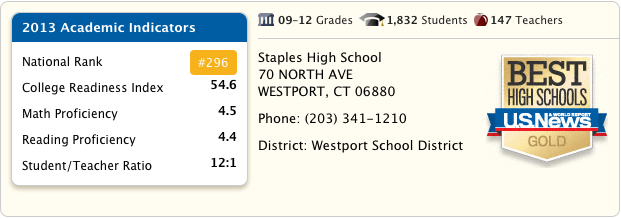U.S. News and World Report recently ranked Staples as the 7th best high school in Connecticut.
If Staples High School students sought to rate the school, they might not come to the same conclusion, or to any conclusion at all about how it compares to others.
U.S. News used a three step process to create their rankings.
Step 1: The first step determined whether each school’s students were performing better than statistically expected for the average student in the state. We started by looking at reading and math results for all students on each state’s high school proficiency tests.
We then factored in the percentage of economically disadvantaged students (who tend to score lower) enrolled at the school to identify the schools that were performing better than statistical expectations.
• Step 2: For those schools that made it past this first step, the second step determined whether the school’s least-advantaged students (black, Hispanic and low-income) were performing better than average for similar students in the state.
We compared each school’s math and reading proficiency rates for disadvantaged students with the statewide results for these student groups and then selected schools that were performing better than this state average.
• Step 3: Schools that made it through the first two steps became eligible to be judged nationally on the final step – college-readiness performance – using Advanced Placement or International Baccalaureate test data as the benchmarks for success, depending on which program was largest at the school.
Needless to say, Staples students are not privy to this information.
But even if they were, they probably wouldn’t use it. These statistics, to most, have little meaning, and less relevance. Those who attend Staples every day for four years, who know the fastest way from the cafeteria to their first period calculus class, who can explain how the lunch waves work, who spend free periods in a learning center, have no idea how they compare to the average student in their demographic.
No, Staples students would focus on their own experiences: of stimulating conversations with passionate teachers, of studying test banks instead of understanding material, of cheering for the football team under the lights, or of sitting in the freshmen “ghetto” during lunch.
It would be these things, things that students actually know, that they would use to rank their own school.
Something else students at Staples don’t actually know? How their school compares to others, because, once again, they are Staples students. Why would they know about the math proficiency levels in Darien, the school who was ranked #1 in the state.
Why should they?
If Darien students were worse at math, it wouldn’t make Staples students any better. If everyone were worse at math, Staples might be ranked #1 instead of Darien, but its students still wouldn’t be any better at math.
Staples’ rank, as determined by U.S. News or by anyone else, is defined only relatively. Staples High School, and each high school, defines itself.













































